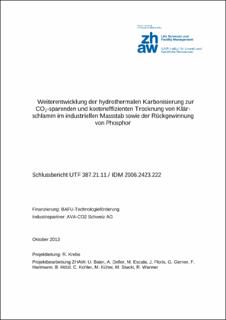Please use this identifier to cite or link to this item:
https://doi.org/10.21256/zhaw-4975| Publication type: | Working paper – expertise – study |
| Title: | Weiterentwicklung der hydrothermalen Karbonisierung zur CO2-sparenden und kosteneffizienten Trocknung von Klärschlamm im industriellen Massstab sowie der Rückgewinnung von Phosphor |
| Authors: | Krebs, Rolf Baier, Urs Deller, Annica Escala, Marina Floris, Julien Gerner, Gabriel Hartmann, Frank Hölzl, Britta Kohler, Christoph Kühni, Martin Stucki, Matthias Wanner, Rahel |
| DOI: | 10.21256/zhaw-4975 |
| Extent: | 114 |
| Issue Date: | 2013 |
| Series: | Schriftenreihe Erneuerbare Energien, Bodenökologie und Ökotechnologie |
| Publisher / Ed. Institution: | ZHAW Zürcher Hochschule für Angewandte Wissenschaften |
| Publisher / Ed. Institution: | Winterthur |
| Language: | German |
| Subjects: | Sewage sludge; Hydro-thermal carbonization; Drying; Costs |
| Subject (DDC): | 620: Engineering |
| Abstract: | In Switzerland, sewage sludge has to be burned since 2006. So far the necessary drying was done by thermal methods with high inputs of energy. In this project we investigate hydrothermal carbonisation (HTC) as CO2 saving and cost efficient alternative to dry sewage sludge on industrial scale. The focus in this applied research project is on the process water treatment, the mechanical dewatering, the potential use of HTC coal, the recycling of phosphorus and heavy metals and an assessment of environmental effects of HTC compared to current treatments. The potential for biological decomposition was investigated in HTC process water and permeat, which was gained by membrane filtration of HTC process water. A medium to high decomposition rate was shown for organic matter in HTC process water and permeat by aerobic and anaerobic processes in batch experiments. In a continuous aerobic laboratory reactor the HTC process water and permeat showed decomposition rates of 70-75% for chemical oxygen demand (COD) at a specific load of 5-10 kg COD/(m3 reactor volume*d). In the competition for a HTC-stage at the Oftringen waste water treatment plant (WWTP) an increase of dissolved organic carbon (DOC) due to the addition of HTC-permeate is limited to 3 mg/l in the effluent of the WWTP. This value can be reached by an optimised membrane filtration with no further treatment for most cases. Advantages of HTC for the mechanical dewatering were shown with a filter press on industrual scale. HTC coal was successfully burned in mono- and mixed combustion plants on industrial scale, for example at Jura Cement in Wildegg or the sludge combustion plant (SVA) in Winterthur. At SVA additional fossil fuels could be temporarily fully substituted by HTC coal. Additional experiments on industrial scale are planned. No evidence of decreased recycling capability of phosphorus or heavy metals after carbonisation was found. Compared to the currently applied sewage sludge drying process the waste heat could be reduced by up to 62% and the electricity demand by up to 69% with HTC. A detailled life cycle assessment showed little differences of HTC compared to the thermal drying process with waste heat but significant advantages compared to the thermal process of drying with fossil fuels. HTC is most promising concerning minimal environmental effects if optimizing measures are applied such as the reduction of phosphorus and nitrogen in the HTC process water, the recycling of phosphorus and the use of lost heat, renewable energy sources such as sewage gas, wood chips, green electricity on adequate sites and if the produced HTC coal is used as substitute of fossil fuels, for example in cement industry or brown coal power plants. Currently a detailled technical study is prepared by AVA-CO2 and another competitor for the first industrial HTC plant in Switzerland to dry sewage sludge at the WWTP Oftringen. |
| URI: | https://digitalcollection.zhaw.ch/handle/11475/14384 |
| License (according to publishing contract): | CC BY 4.0: Attribution 4.0 International |
| Departement: | Life Sciences and Facility Management |
| Organisational Unit: | Institute of Natural Resource Sciences (IUNR) |
| Published as part of the ZHAW project: | Hydrothermale Carbonisierung als Alternative zur thermalen Trocknung von Klärschlamm |
| Appears in collections: | Schriftenreihe Erneuerbare Energien, Bodenökologie, Ökobilanzierung, Ökotechnologie und Aquakultur |
Files in This Item:
| File | Description | Size | Format | |
|---|---|---|---|---|
| 2013_Krebs_Weiterentwicklung_der_hydrothermalen_Karbonisierung_zur_CO2-sparenden.pdf | 4.54 MB | Adobe PDF |  View/Open |
Show full item record
Krebs, R., Baier, U., Deller, A., Escala, M., Floris, J., Gerner, G., Hartmann, F., Hölzl, B., Kohler, C., Kühni, M., Stucki, M., & Wanner, R. (2013). Weiterentwicklung der hydrothermalen Karbonisierung zur CO2-sparenden und kosteneffizienten Trocknung von Klärschlamm im industriellen Massstab sowie der Rückgewinnung von Phosphor. ZHAW Zürcher Hochschule für Angewandte Wissenschaften. https://doi.org/10.21256/zhaw-4975
Krebs, R. et al. (2013) Weiterentwicklung der hydrothermalen Karbonisierung zur CO2-sparenden und kosteneffizienten Trocknung von Klärschlamm im industriellen Massstab sowie der Rückgewinnung von Phosphor. Winterthur: ZHAW Zürcher Hochschule für Angewandte Wissenschaften. Available at: https://doi.org/10.21256/zhaw-4975.
R. Krebs et al., “Weiterentwicklung der hydrothermalen Karbonisierung zur CO2-sparenden und kosteneffizienten Trocknung von Klärschlamm im industriellen Massstab sowie der Rückgewinnung von Phosphor,” ZHAW Zürcher Hochschule für Angewandte Wissenschaften, Winterthur, 2013. doi: 10.21256/zhaw-4975.
KREBS, Rolf, Urs BAIER, Annica DELLER, Marina ESCALA, Julien FLORIS, Gabriel GERNER, Frank HARTMANN, Britta HÖLZL, Christoph KOHLER, Martin KÜHNI, Matthias STUCKI und Rahel WANNER, 2013. Weiterentwicklung der hydrothermalen Karbonisierung zur CO2-sparenden und kosteneffizienten Trocknung von Klärschlamm im industriellen Massstab sowie der Rückgewinnung von Phosphor. Winterthur: ZHAW Zürcher Hochschule für Angewandte Wissenschaften
Krebs, Rolf, Urs Baier, Annica Deller, Marina Escala, Julien Floris, Gabriel Gerner, Frank Hartmann, et al. 2013. “Weiterentwicklung der hydrothermalen Karbonisierung zur CO2-sparenden und kosteneffizienten Trocknung von Klärschlamm im industriellen Massstab sowie der Rückgewinnung von Phosphor.” Winterthur: ZHAW Zürcher Hochschule für Angewandte Wissenschaften. https://doi.org/10.21256/zhaw-4975.
Krebs, Rolf, et al. Weiterentwicklung der hydrothermalen Karbonisierung zur CO2-sparenden und kosteneffizienten Trocknung von Klärschlamm im industriellen Massstab sowie der Rückgewinnung von Phosphor. ZHAW Zürcher Hochschule für Angewandte Wissenschaften, 2013, https://doi.org/10.21256/zhaw-4975.
Items in DSpace are protected by copyright, with all rights reserved, unless otherwise indicated.